
How to Use SIM900A gsm module: Examples, Pinouts, and Specs
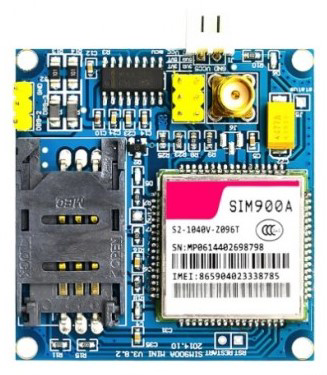
 Design with SIM900A gsm module in Cirkit Designer
Design with SIM900A gsm module in Cirkit DesignerIntroduction
The SIM900A is a compact and reliable GSM/GPRS module designed for communication over mobile networks. It enables devices to send and receive SMS, make voice calls, and connect to the internet using GPRS. This module is widely used in IoT applications, remote monitoring systems, and embedded projects requiring mobile connectivity.
Explore Projects Built with SIM900A gsm module
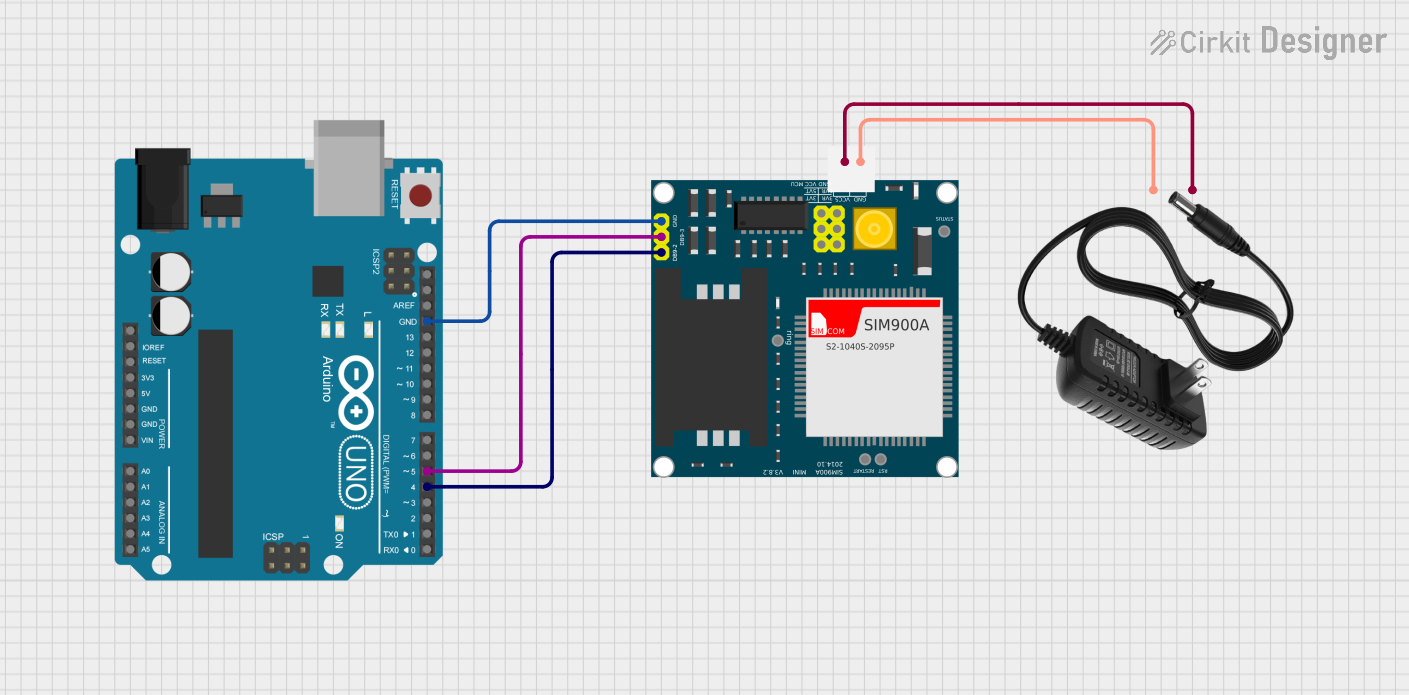
 Open Project in Cirkit Designer
Open Project in Cirkit Designer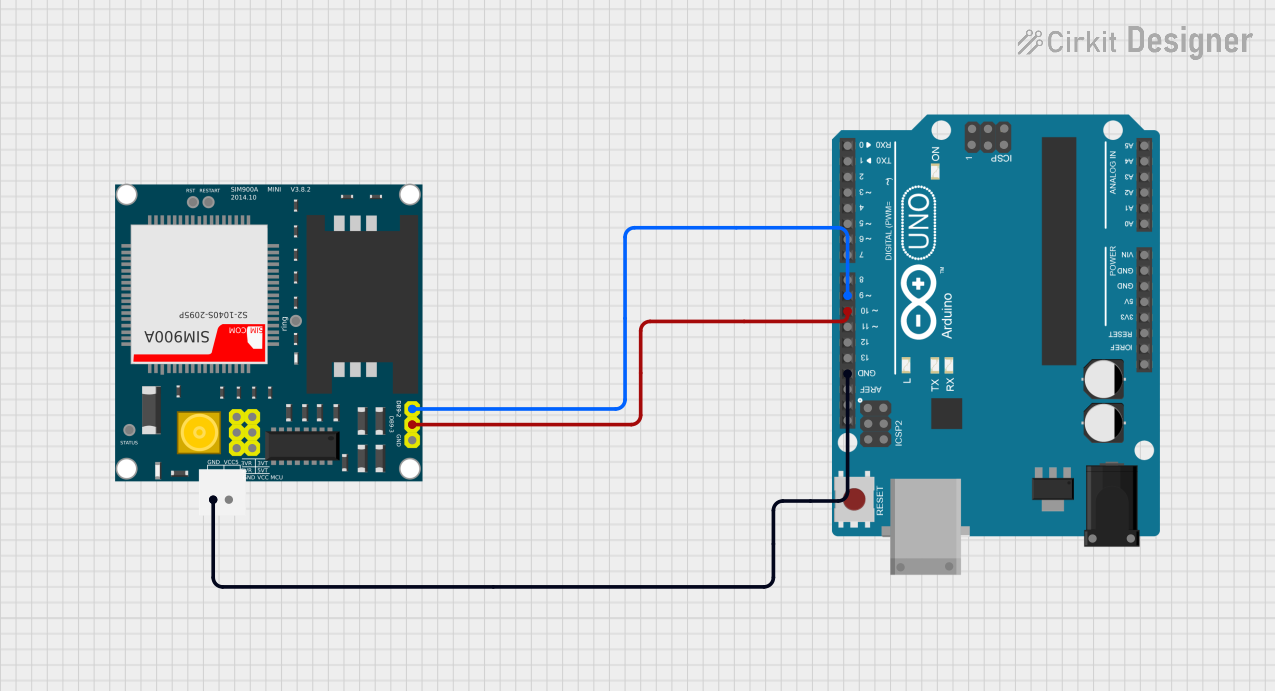
 Open Project in Cirkit Designer
Open Project in Cirkit Designer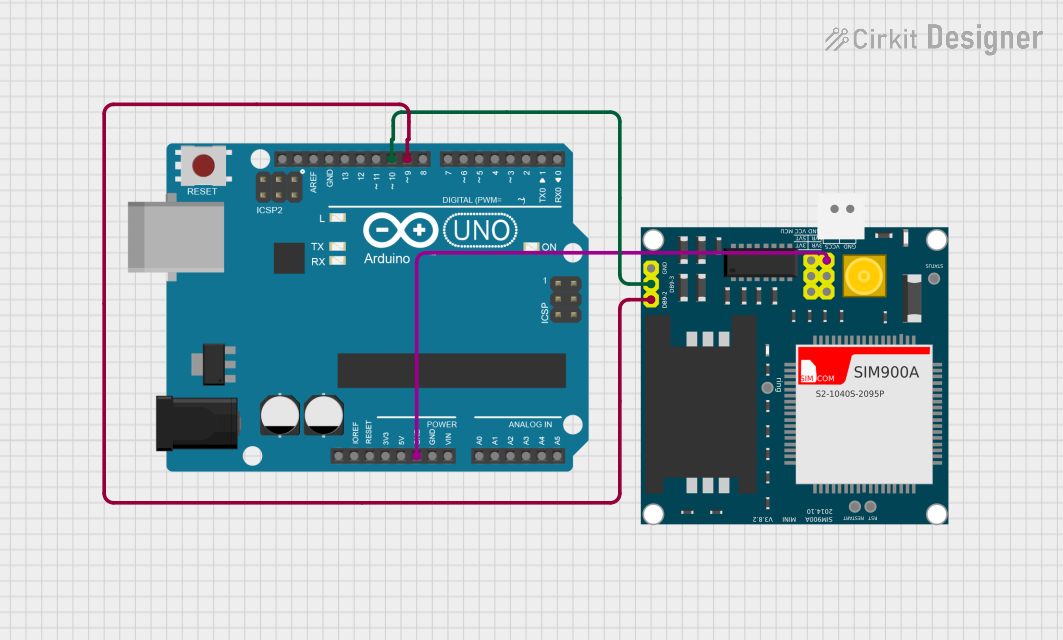
 Open Project in Cirkit Designer
Open Project in Cirkit Designer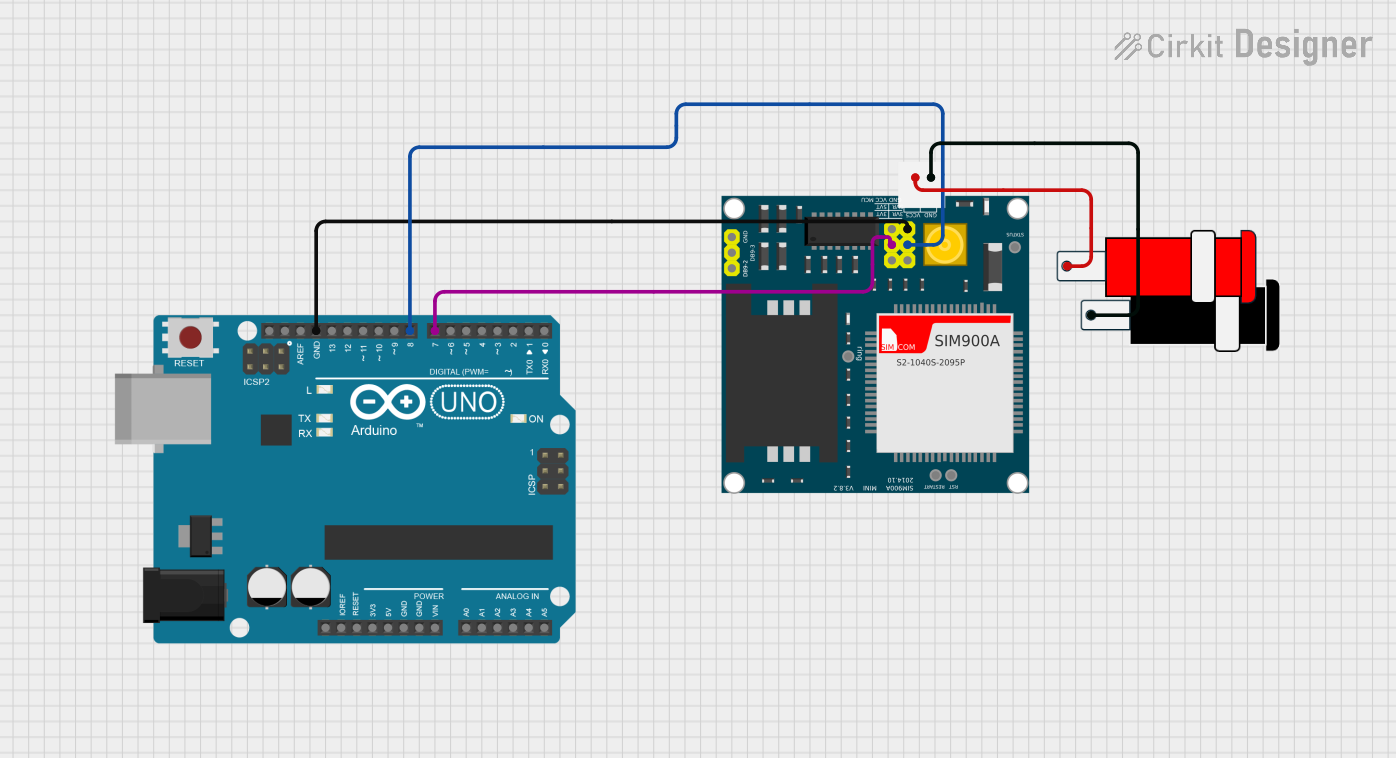
 Open Project in Cirkit Designer
Open Project in Cirkit DesignerExplore Projects Built with SIM900A gsm module

 Open Project in Cirkit Designer
Open Project in Cirkit Designer
 Open Project in Cirkit Designer
Open Project in Cirkit Designer
 Open Project in Cirkit Designer
Open Project in Cirkit Designer
 Open Project in Cirkit Designer
Open Project in Cirkit DesignerCommon Applications and Use Cases
- IoT Devices: Enables remote communication for smart devices.
- Home Automation: Facilitates SMS-based control of appliances.
- Vehicle Tracking: Provides real-time location updates via GPRS.
- Remote Monitoring: Sends alerts or data from sensors to mobile devices.
- Embedded Systems: Adds GSM/GPRS functionality to microcontroller-based projects.
Technical Specifications
The SIM900A module is designed to operate efficiently in a variety of environments. Below are its key technical details:
Key Technical Details
- Operating Voltage: 3.4V to 4.4V (typical 4.0V)
- Power Consumption:
- Idle: ~1.5mA
- GSM Transmission: ~200mA (average), ~2A (peak)
- Frequency Bands: Dual-band GSM 900/1800 MHz
- Communication Interface: UART (up to 115200 bps)
- SIM Card Support: 1.8V and 3.0V SIM cards
- GPRS: Class 10 (max 85.6 kbps)
- Operating Temperature: -40°C to +85°C
- Dimensions: 24mm x 24mm x 3mm
Pin Configuration and Descriptions
The SIM900A module typically comes with a breakout board for easier interfacing. Below is the pin configuration:
| Pin Name | Description |
|---|---|
| VCC | Power supply input (3.4V to 4.4V) |
| GND | Ground |
| TXD | UART Transmit (connect to RX of MCU) |
| RXD | UART Receive (connect to TX of MCU) |
| DTR | Data Terminal Ready (for sleep mode) |
| RST | Reset pin (active low) |
| SIM_VDD | SIM card power supply |
| SIM_DATA | SIM card data line |
| SIM_CLK | SIM card clock line |
| SIM_RST | SIM card reset line |
| NETLIGHT | Network status indicator (LED output) |
| STATUS | Module status indicator |
| MIC+ | Microphone positive input |
| MIC- | Microphone negative input |
| SPK+ | Speaker positive output |
| SPK- | Speaker negative output |
Usage Instructions
The SIM900A module can be easily integrated into a circuit for GSM/GPRS communication. Below are the steps and best practices for using the module:
How to Use the SIM900A in a Circuit
- Power Supply: Ensure a stable power supply of 4.0V with sufficient current (at least 2A peak). Use a capacitor (e.g., 1000µF) near the module to handle voltage drops during transmission.
- Connect UART Pins: Connect the TXD and RXD pins of the module to the RX and TX pins of your microcontroller, respectively. Use a level shifter if your microcontroller operates at 5V logic.
- Insert SIM Card: Insert a valid SIM card into the SIM card slot. Ensure the SIM card is activated and has sufficient balance for SMS, calls, or data.
- Antenna: Attach a GSM antenna to the module for better signal reception.
- Power On: Power on the module and wait for the NETLIGHT LED to blink, indicating network registration.
- Send AT Commands: Use a serial terminal or microcontroller to send AT commands for communication. For example:
AT(Check module response)AT+CMGF=1(Set SMS mode to text)AT+CMGS="+1234567890"(Send SMS to a phone number)
Important Considerations and Best Practices
- Voltage Levels: Ensure the UART voltage levels match the microcontroller. Use a level shifter if necessary.
- Antenna Placement: Place the antenna away from other components to avoid interference.
- Network Compatibility: The SIM900A supports GSM 900/1800 MHz bands. Ensure your region supports these frequencies.
- Power Supply: Use a low-noise power supply to avoid communication issues.
- Error Handling: Always check the response of AT commands to handle errors effectively.
Example: Connecting SIM900A to Arduino UNO
Below is an example of how to send an SMS using the SIM900A module and an Arduino UNO:
#include <SoftwareSerial.h>
// Define RX and TX pins for SoftwareSerial
SoftwareSerial SIM900A(7, 8); // RX = Pin 7, TX = Pin 8
void setup() {
// Initialize serial communication
Serial.begin(9600); // For debugging
SIM900A.begin(9600); // For SIM900A communication
// Wait for the module to initialize
delay(1000);
Serial.println("Initializing SIM900A...");
// Send AT command to check module response
SIM900A.println("AT");
delay(1000);
while (SIM900A.available()) {
Serial.write(SIM900A.read()); // Print module response
}
// Set SMS mode to text
SIM900A.println("AT+CMGF=1");
delay(1000);
// Send SMS
SIM900A.println("AT+CMGS=\"+1234567890\""); // Replace with recipient's number
delay(1000);
SIM900A.println("Hello from SIM900A!"); // SMS content
delay(1000);
SIM900A.write(26); // Send Ctrl+Z to send the SMS
delay(5000);
Serial.println("SMS sent!");
}
void loop() {
// Nothing to do here
}
Troubleshooting and FAQs
Common Issues and Solutions
Module Not Responding to AT Commands:
- Cause: Incorrect UART connection or baud rate.
- Solution: Verify TX and RX connections. Ensure the baud rate matches the module's default (9600 bps).
Network Registration Fails:
- Cause: Poor signal strength or unsupported frequency band.
- Solution: Check the antenna connection and ensure your SIM card supports GSM 900/1800 MHz.
SMS Not Sending:
- Cause: Incorrect SMS mode or insufficient balance.
- Solution: Set SMS mode to text using
AT+CMGF=1and verify SIM card balance.
Module Restarts During Transmission:
- Cause: Insufficient power supply.
- Solution: Use a power supply capable of providing at least 2A peak current.
FAQs
Q: Can the SIM900A connect to 3G or 4G networks?
A: No, the SIM900A only supports GSM 900/1800 MHz bands.Q: How do I check the signal strength?
A: Use the AT commandAT+CSQ. The response indicates signal quality (e.g.,+CSQ: 20,0).Q: Can I use the SIM900A with a 5V microcontroller?
A: Yes, but you must use a level shifter to convert 5V logic to 3.3V for the module's UART pins.Q: How do I reset the module?
A: Pull the RST pin low for at least 100ms to reset the module.